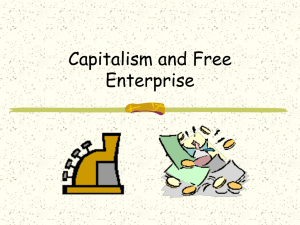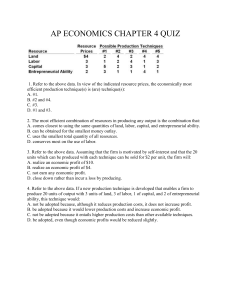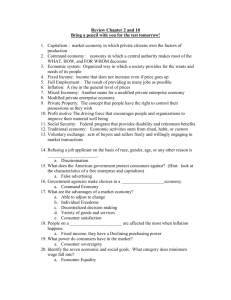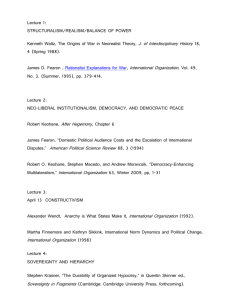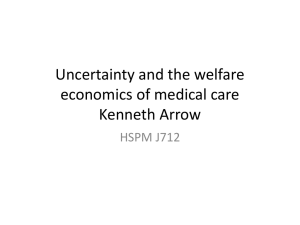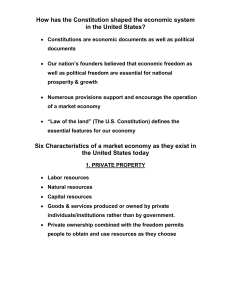Economic Systems and Decision Making
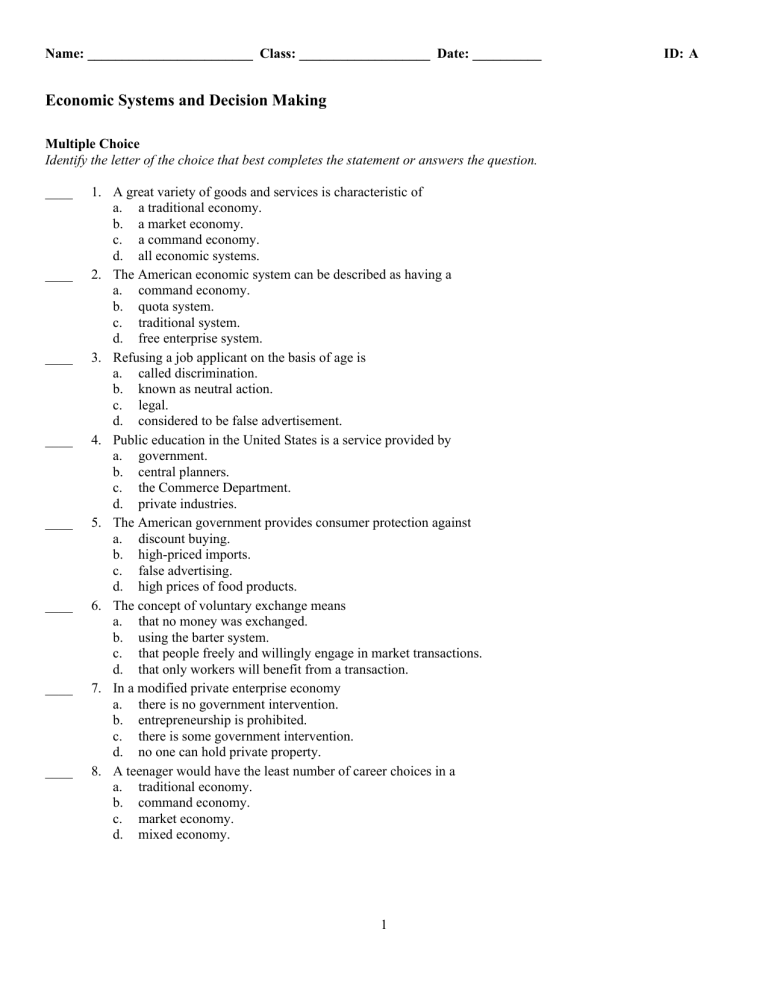
Name: ________________________ Class: ___________________ Date: __________
Economic Systems and Decision Making
Multiple Choice
Identify the letter of the choice that best completes the statement or answers the question.
____ 1. A great variety of goods and services is characteristic of a.
a traditional economy.
b.
a market economy.
c.
a command economy.
d.
all economic systems.
____ 2. The American economic system can be described as having a a.
command economy.
b.
quota system.
c.
traditional system.
d.
free enterprise system.
____ 3. Refusing a job applicant on the basis of age is a.
called discrimination.
b.
known as neutral action.
c.
legal.
d.
considered to be false advertisement.
____ 4. Public education in the United States is a service provided by a.
government.
b.
central planners.
c.
the Commerce Department.
d.
private industries.
____ 5. The American government provides consumer protection against a.
discount buying.
b.
high-priced imports.
c.
false advertising.
d.
high prices of food products.
____ 6. The concept of voluntary exchange means a.
that no money was exchanged.
b.
using the barter system.
c.
that people freely and willingly engage in market transactions.
d.
that only workers will benefit from a transaction.
____ 7. In a modified private enterprise economy a.
there is no government intervention.
b.
entrepreneurship is prohibited.
c.
there is some government intervention.
d.
no one can hold private property.
____ 8. A teenager would have the least number of career choices in a a.
traditional economy.
b.
command economy.
c.
market economy.
d.
mixed economy.
1
ID: A
Name: ________________________
____ 9. Choices in a command economy are made by a.
private business.
b.
assembly line workers.
c.
competition.
d.
government agencies.
____ 10. An advantage of a market economy is its ability to a.
control the price of labor.
b.
adjust to changes over time.
c.
sell goods at a high price.
d.
limit consumer choices.
____ 11. An organized way of providing for the wants and needs of people is known as a.
an economic system.
b.
economic interdependence.
c.
a fixed income.
d.
the profit motive.
____ 12. During periods of inflation, people living on a fixed income have a.
no financial problems.
b.
declining purchasing power.
c.
unlimited resources.
d.
no voice in the government.
____ 13. The power of the consumer in the market is a.
supply and demand.
b.
opportunity cost.
c.
consumer sovereignty.
d.
trade-offs.
____ 14. Which of the following is NOT considered an economic and social goal?
a.
economic efficiency b.
price stability c.
economic growth d.
entrepreneurship
____ 15. Which group of people ultimately determines the products that a free enterprise economy produces?
a.
Congress b.
property owners c.
consumers d.
local officials
____ 16. The purpose of government in a command economy is to a.
prevent imports.
b.
encourage the formation of corporations.
c.
promote economic freedom.
d.
make major economic decisions.
____ 17. Refusing a job applicant on the basis of religious preference is a.
known as a neutral action.
b.
considered to be false advertisement.
c.
called discrimination.
d.
legal.
ID: A
2
Name: ________________________
____ 18. Both parties to a transaction benefit according to a.
voluntary exchange.
b.
consumer sovereignty.
c.
fixed income.
d.
command economy.
____ 19. Higher profits, new businesses, and higher paying jobs are all benefits derived from successful a.
entrepreneurship.
b.
charitable organizations.
c.
monopolies.
d.
central planning.
____ 20. The former Soviet Union is an example of a.
capitalism.
b.
a command economy.
c.
a market economy.
d.
free enterprise.
____ 21. An economic system is successful when it a.
creates a large number of wealthy people.
b.
maintains normal unemployment levels.
c.
controls government agencies.
d.
satisfies the needs of its people.
____ 22. An entrepreneur would most likely have the best chance for success in a.
a command economy.
b.
a market economy.
c.
a traditional economy.
d.
any of the economies.
____ 23. Consumer sovereignty refers to a.
the power of buyers.
b.
manufacturers.
c.
advertising.
d.
the media.
____ 24. In a modified private enterprise economy based on capitalism, government plays the role of a.
definer of social and economic goals.
b.
central planner deciding WHAT to produce.
c.
regulator charged with preserving competition in the marketplace.
d.
coordinator of basic economic activity.
____ 25. A rapid increase in the general level of prices is called a.
inflation.
b.
deflation.
c.
a market economy.
d.
a depression.
____ 26. The minimum wage is an example of a federal law that supports which economic goal?
a.
economic growth b.
economic equity c.
full employment d.
economic efficiency
ID: A
3
Name: ________________________
____ 27. Under capitalism, an incentive to work, save, and invest is due to a.
the Social Security system.
b.
voluntary exchange.
c.
the ability to own private property.
d.
consumer sovereignty.
____ 28. The economic system in the United States can best be described as a a.
modified private enterprise system.
b.
pure free enterprise system.
c.
traditional system.
d.
command economy.
____ 29. Changes in a market economy tend to be a.
revolutionary.
b.
prohibited.
c.
gradual.
d.
discouraged.
____ 30. In the traditional Inuit society, there was the willingness to a.
share goods and services.
b.
hoard goods and services.
c.
compete.
d.
continually set new goals.
Matching
Match each item with the correct statement below.
a.
Social Security f.
capitalism b.
command economy c.
inflation d.
fixed income e.
profit motive g.
h.
i.
j.
traditional economy mixed economy private property full employment
____ 31. the concept that people have the right to control their possessions as they wish
____ 32. another name for a modified private enterprise economy
____ 33. economic activities stem from ritual, habit, or custom
____ 34. economy with extensive government involvement
____ 35. federal program that provides disability and retirement benefits
____ 36. a rise in the general level of prices
____ 37. income that doesn't increase even though the cost of living goes up
____ 38. the result of providing as many jobs as possible
____ 39. private citizens own the factors of production
____ 40. a reason why many people become entrepreneurs
Match each item with the correct statement below.
a.
economic freedom f.
consumer sovereignty b.
entrepreneur c.
voluntary exchange g.
h.
Social Security economic system d.
profit e.
fixed income i.
command economy j.
market economy
____ 41. buyers and sellers engaging in transactions
4
ID: A
Name: ________________________ ID: A
____ 42. reflects goal of economic security
____ 43. central authority makes most economic decisions
____ 44. organized way of providing for needs and wants of a society
____ 45. extent to which a person is better off at the end of a period
____ 46. a cornerstone of American society
____ 47. income stays the same, even though cost of living goes up
____ 48. describes consumer as "ruler" of the market
____ 49. a risk-taker
____ 50. allows buyers and sellers to come together to exchange goods and services
Short Answer
51.
Critical Thinking Compare a command economy to a market economy by listing a strength and weakness of each. State how each type of economy satisfies the wants and needs of individuals.
52.
Critical Thinking List and explain four characteristics of a free enterprise economy.
5
Name: ________________________
Economic Systems and Decision Making
Answer Section
MULTIPLE CHOICE
16. D
17. C
18. A
19. A
20. B
21. D
22. B
23. A
24. C
25. A
26. B
27. C
28. A
29. C
30. A
9. D
10. B
11. A
12. B
13. C
14. D
15. C
1. B
2. D
3. A
4. A
5. C
6. C
7. C
8. A
MATCHING
31. I
32. H
33. G
34. B
35. A
36. C
37. D
6
ID: A
Name: ________________________ ID: A
38. J
39. F
40. E
41. C
42. G
43. I
44. H
45. D
46. A
47. E
48. F
49. B
50. J
SHORT ANSWER
51. The strength of a command economy is that it can change direction drastically in a relatively short amount of time. Its weaknesses: It is not designed to meet the wants and needs of individuals, it lacks incentives for people to work hard, it requires a large decision-making bureaucracy, it does not have the flexibility to deal with minor problems, and people with new or unique ideas find it difficult to get ahead. In a command economy a central planning committee decides on how best to satisfy the needs of individuals. The strengths of a market economy: It can adjust to change over time, freedom exists for everyone involved, it has a relatively small degree of government interference, decision making is decentralized, it provides an incredible variety of goods and services to consumers, and has a high degree of consumer satisfaction. Weaknesses of a market economy: The rewards go to the most productive resources, and sometimes markets do not work as they should. A market economy satisfies the needs and wants of individuals by offering products that the consumer requests.
52. Four characteristics of a free enterprise economy: (1) economic freedom--people are free to choose their jobs, and businesses are free to hire the best people, (2) voluntary exchange--the act of buyers and sellers freely and willingly engaging in market transactions, (3) private property--people have the right and privilege to control their possessions as they wish, (4) profit motive--people are free to risk their savings or any part of their wealth in a business venture.
7
